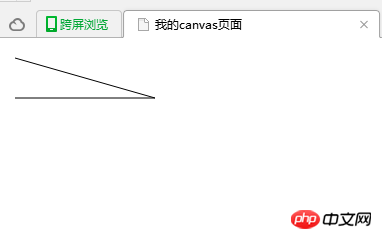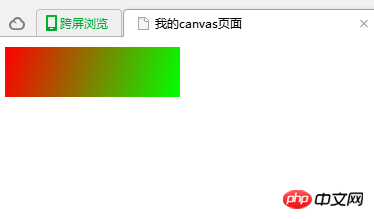Detailed explanation of HTML5 canvas (1)
The
canvas element in HTML5 is used to draw graphics on web pages.
Features of Canvas
The Canvas canvas is a rectangular area, each of its pixels can be controlled
Canvas uses JavaScript to Control drawing
Canvas has methods for lines, rectangles, circles and adding images
Usage of Canvas tag
The following The code is to use the canvas screen to draw a 200*200 red rectangle:
<!Doctype html>
<html>
<head>
<title>我的canvas页面</title>
<meta charset="utf-8"/>
</head>
<body>
<canvas id="myCanvas" width="200" height="200">
</canvas>
<script type="text/javascript">
var c=document.getElementById("myCanvas"); var cxt=c.getContext("2d");
cxt.fillStyle="#FF0000";
cxt.fillRect(0,0,200,200);
</script>
</body>
</html>Save the above code as canvas.html, and set its encoding to utf-8 (otherwise the Chinese will be garbled), and open it with a browser You can see the following effect: 
<canvas id="myCanvas" width="200" style="max-width:90%">
HereCreate the Canvas tag and define its id as myCanvas, which is convenient for JavaScript to obtain the tag when drawing Object.
Look at the JavaScript drawing part again:
var c=document.getElementById("myCanvas");
var cxt=c.getContext("2d");
cxt.fillStyle="#FF0000";
cxt.fillRect(0,0,200,200);The first sentence, getElementById, gets the canvas object through the ID of the Canvas tag.
The second sentence, getContext, gets the context object.
The third sentence calls the method fillStyle of the Context object, that is, fills its color.
The fourth sentence calls the fillRect method of the Context object to specify the filled area.
Other instances of Canvas
Straight line
<!Doctype html><html><head><title>我的canvas页面</title>
<meta charset="utf-8"/>
</head>
<body>
<canvas id="myCanvas" width="200" height="200">
</canvas>
<script type="text/javascript">
var c=document.getElementById("myCanvas");
var cxt=c.getContext("2d");
cxt.moveTo(10,10);
cxt.lineTo(150,50);
cxt.lineTo(10,50);
cxt.stroke();</script></body></html>The running results are as follows: 
Circle
<!Doctype html>
<html>
<head>
<title>我的canvas页面</title>
<meta charset="utf-8"/>
</head>
<body>
<canvas id="myCanvas" width="200" height="200">
</canvas>
<script type="text/javascript">
var c=document.getElementById("myCanvas");
var cxt=c.getContext("2d");
cxt.fillStyle="#FF0000";
cxt.beginPath();
cxt.arc(70,18,15,0,Math.PI*2,true);
cxt.closePath();
cxt.fill();</script></body></html>The running results As follows: 
Gradient
<!Doctype html><html><head><title>我的canvas页面</title>
<meta charset="utf-8"/>
</head>
<body>
<canvas id="myCanvas" width="200" height="200">
</canvas>
<script type="text/javascript">
var c=document.getElementById("myCanvas");
var cxt=c.getContext("2d");
var grd=cxt.createLinearGradient(0,0,175,50);
grd.addColorStop(0,"#FF0000");
grd.addColorStop(1,"#00FF00");
cxt.fillStyle=grd;
cxt.fillRect(0,0,175,50);
</script>
</body>
</html>The effect is as follows: 
Image
<!Doctype html>
<html>
<head>
<title>我的canvas页面</title>
<meta charset="utf-8"/>
</head>
<body>
<canvas id="myCanvas" width="800" height="600">
</canvas>
<script type="text/javascript">
var c=document.getElementById("myCanvas");
var cxt=c.getContext("2d");
var img=new Image();
img.src="1.png";
img.onload=function(e){
cxt.drawImage(img,0,0);
}
cxt.drawImage(img,0,0);
</script>
</body>
</html>Note, Be sure to add onload event to Img, otherwise the image will not be displayed.
Among them, 1.png is the picture material I found for myself. When you open the page, you can see that the image is displayed in the canvas. My running effect is as follows, the pictures can be found randomly on Baidu, just look at it~~ 
The above is the detailed content of Detailed explanation of HTML5 canvas (1). For more information, please follow other related articles on the PHP Chinese website!

Hot AI Tools

Undresser.AI Undress
AI-powered app for creating realistic nude photos

AI Clothes Remover
Online AI tool for removing clothes from photos.

Undress AI Tool
Undress images for free

Clothoff.io
AI clothes remover

Video Face Swap
Swap faces in any video effortlessly with our completely free AI face swap tool!

Hot Article

Hot Tools

Notepad++7.3.1
Easy-to-use and free code editor

SublimeText3 Chinese version
Chinese version, very easy to use

Zend Studio 13.0.1
Powerful PHP integrated development environment

Dreamweaver CS6
Visual web development tools

SublimeText3 Mac version
God-level code editing software (SublimeText3)

Hot Topics
 1386
1386
 52
52
 Table Border in HTML
Sep 04, 2024 pm 04:49 PM
Table Border in HTML
Sep 04, 2024 pm 04:49 PM
Guide to Table Border in HTML. Here we discuss multiple ways for defining table-border with examples of the Table Border in HTML.
 HTML margin-left
Sep 04, 2024 pm 04:48 PM
HTML margin-left
Sep 04, 2024 pm 04:48 PM
Guide to HTML margin-left. Here we discuss a brief overview on HTML margin-left and its Examples along with its Code Implementation.
 Nested Table in HTML
Sep 04, 2024 pm 04:49 PM
Nested Table in HTML
Sep 04, 2024 pm 04:49 PM
This is a guide to Nested Table in HTML. Here we discuss how to create a table within the table along with the respective examples.
 HTML Table Layout
Sep 04, 2024 pm 04:54 PM
HTML Table Layout
Sep 04, 2024 pm 04:54 PM
Guide to HTML Table Layout. Here we discuss the Values of HTML Table Layout along with the examples and outputs n detail.
 HTML Input Placeholder
Sep 04, 2024 pm 04:54 PM
HTML Input Placeholder
Sep 04, 2024 pm 04:54 PM
Guide to HTML Input Placeholder. Here we discuss the Examples of HTML Input Placeholder along with the codes and outputs.
 Moving Text in HTML
Sep 04, 2024 pm 04:45 PM
Moving Text in HTML
Sep 04, 2024 pm 04:45 PM
Guide to Moving Text in HTML. Here we discuss an introduction, how marquee tag work with syntax and examples to implement.
 HTML Ordered List
Sep 04, 2024 pm 04:43 PM
HTML Ordered List
Sep 04, 2024 pm 04:43 PM
Guide to the HTML Ordered List. Here we also discuss introduction of HTML Ordered list and types along with their example respectively
 HTML onclick Button
Sep 04, 2024 pm 04:49 PM
HTML onclick Button
Sep 04, 2024 pm 04:49 PM
Guide to HTML onclick Button. Here we discuss their introduction, working, examples and onclick Event in various events respectively.




